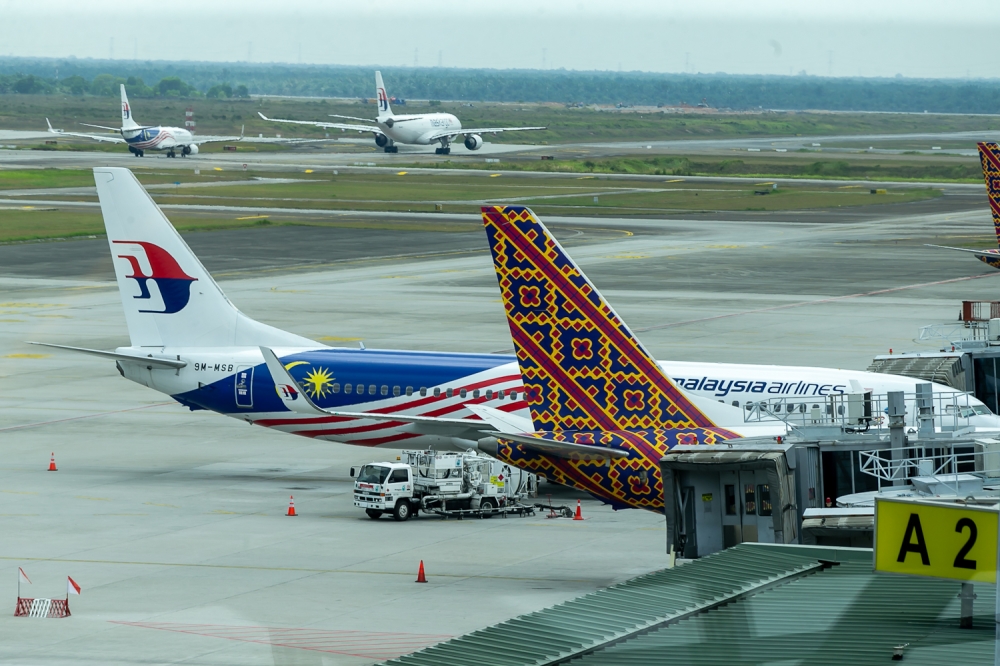KUALA LUMPUR, May 31 — Sustainable aviation fuels (SAF) appears to be the latest trendy buzzword among politicians.
Last week, Transport Minister Anthony Loke touted SAF as the key to decarbonising an industry that is fast becoming one of the biggest global carbon emitters, thanks to the world’s insatiable thirst for flying cheaply.
Before him, Sarawak Premier Tan Sri Abang Johari Openg also expressed his intention to make the state’s newly launched “boutique” airline the world’s poster boy of so-called green jet fuel.
This sudden interest in SAF has been linked to the government’s effort to turn the country into a low-carbon economy. Like many others, Malaysia — a car-centric nation, fossil fuel exporter, and the second largest palm oil producer, which activists have blamed for deforestation in the region — was quick to jump on the “sustainability” bandwagon.
But buzzwords can sometimes be deceiving. In the case of “sustainability,” environmentalists said it has become a convenient way for some of the heaviest polluting industries to greenwash their dirty businesses.
So, is SAF really green? We look at what news reports and studies have said:
What are SAFs?
SAFs has been touted as the best alternative to traditional jet fuel because it supposedly reduces up to 80 per cent of carbon emissions that come out of kerosene, the main component of fuels powering planes.
The reason for this is because SAS is made mostly of industrial waste products like used cooking oil and feedstocks, also called biomass. There are also talks about using hydrogen or synthetic kerosene.
Why the interest in SAFs?
According to the Centre for Climate and Energy, the aviation industry accounted for more than two per cent of global carbon dioxide released in the air from 1990 to 2010, which grew by nearly half of that from 2013 to 2018, coinciding with the boom in budget airlines.
The BBC reported that just a single aircraft uses an “incredible” amount of fuel. A Boeing 747-400 jumbo jet, for example, uses up to 240,000L of jet fuel, equal to about a 10th of an Olympic sized swimming pool, and burns through it at a rate of 4L per second.
In 2021, the International Air Transport Association released a plan for airlines to achieve net-zero carbon by 2050. Some of the airlines that have made similar commitments include American Airlines, Qantas and Air New Zealand.

Can airlines achieve it with SAFs?
Highly debatable, according to this study, which looked at the dozens of roadmaps the industry set out to cut their carbon footprints; its researchers concluded that SAFs caused more planet-harming problems than solutions.
First, producing biomass fuel requires an intensive amount of clean energy. On average across the roadmaps, producing SAFs was said to require close to a tenth of global renewable electricity and 30 per cent of available biomass in 2050.
Even if that shift were possible, production would still be inadequate. The researchers estimated that up 30 per cent of fuel used by airlines in 2050 would still need to be from fossil fuel.
Second, SAFs production also releases huge amounts of greenhouse gasses, the study found. Growing bio-crops, for instance, requires the use of emissions-intensive fertilisers, harvest machinery and transport.
This could lead to more deforestation to clear the way for biofuel crop growing. If sustainable aviation fuels were produced in this way, they would be considerably worse for the climate than fossil fuels, researchers concluded.
Carbon dioxide is also not the only aviation emission that contributes to climate change. Others include nitrogen oxides, water vapour, and soot; no studies to date have shown how SAFs can address this.
These are just some of the problems the study found about the aviation industry’s plan to bank on SAFs as a key solution. There are more.
How can commercial aviation be greener, then?
The Carbon Offsetting and Reduction Scheme for International Aviation (Corsia), a carbon offsetting “scheme” under the International Civil Aviation Organisation, remains upbeat about SAFs amid concerns raised about them.
In a letter meant to counter “misinformation” about these so-called sustainable fuels published in 2019, Michael Gill, the group’s aviation environment director at the time, said the industry can meet its low carbon target if production of biofuel reaches seven billion litres, or around 2 per cent of all jet fuel use.
Corsia suggested the target is achievable by 2025 if all governments “create enough economies of scale to ensure SAF is financially competitive with kerosene.”
To counter the allegation that SAF demand could lead to deforestation, Gill said the IATA had unanimously passed a resolution in 2017 committing to use only biofuel sources that conserve an “ecological balance” by avoiding the depletion of natural resources.
Where are we today with SAFs?
Most analysts agree it would take a seismic shift to widen SAFs usage in commercial aviation and the Covid-19 pandemic had set the drive for biomass production back, with the IATA conceding that the 2 per cent target by 2025 now seems more unlikely.
SAFs are also still very expensive compared to conventional kerosene-based jet fuel simply because production remains miniscule, which has raised doubts if airlines that are still reeling from the pandemic would want to make that jump.
In Malaysia, SAF production is still only at the discussion stage, with Loke saying it would need the entire “aviation ecosystem” to be mobilised to scale up low carbon jet fuel manufacturing.
Petronas Dagangan Berhad’s Commercial Business is currently a supplier of SAF, Bernama reported. Its head, Hardeep Singh, was quoted as saying that the company would start a pilot project to become a producer of the fuel by year’ end.
However, there remain no guarantees on avoiding the negative effects of SAF production.






















